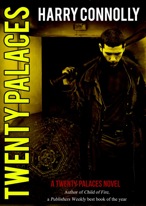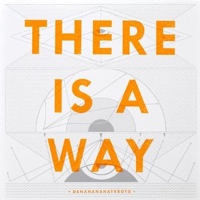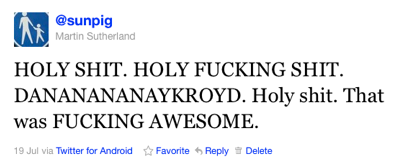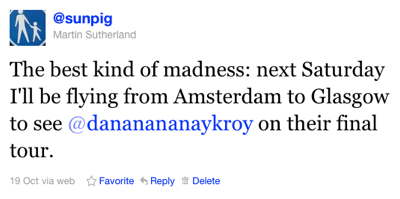When it comes to fiction, in general, I’m a two-genre kind of guy: mysteries and science fiction. There are exceptions, of course, but as a rule historical and faux-historical settings don’t appeal to me. This takes out a lot of fantasy and nixes steampunk as an SF sub-genre. (Even Sue Grafton’s alphabet series, which remains set in the 1980s, drifts further into historical territory with every new book.) Romance is not my cup of tea, either, and high school destroyed any possibility of me ever taking pleasure from literary fiction.
I used to like the occasional piece of horror and slipstream, but until this summer I had no great desire to read urban fantasy. My probably unfair impression of the field was: vampires, werewolves, and woo. Real life is so full of superstition and pseudo-scientific claptrap that my appetite for the paranormal in fiction is diminished by association.
The notable exceptions to my genre-bound reading habits tend to come about as a result of a personal recommendation, or a favourite author trying something different. For example, I’ll read anything Lois McMaster Bujold writes: her Chalion and Sharing Knife series are fantasy, and I love them. My friend Julian suggested Kate Griffin’s Matthew Swift series to me, and I enjoyed the heck out of A Madness of Angels. And I simply adore Charlie Stross’s Laundry series, which are a kind of Lovecraftian tongue-in-cheek (sometimes) spy thriller crossover. Ish.
It was on Charlie’s blog that I first came across Harry Connolly. Harry was writing some guest posts while Charlie was away earlier this year, and I particularly liked his thoughts on “High and Low Thrillers“
Me, I write low thrillers. The setting is generally commonplace and localized, most of the characters are regular folks, and the plot is played out through the exercise of personal agency rather than cultural or organizational power. In fact, one of the most persistent criticisms of my books has been that they don’t have a high thriller insider’s view of the Twenty Palace Society.
Charlie’s recommendation that “if you like my Laundry stories there is a good chance you’ll find Harry’s Twenty Palaces yarns agreeable” was good enough for me, and Harry’s first book, Child of Fire found its way into my shopping basket in time for the summer holidays.
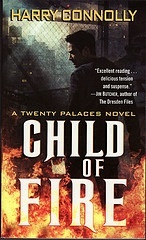 Although my reaction upon finishing the book was, “Great! Want more!” my first impressions were mixed, because I came to the book with skewed expectations. Thinking that it was going to be like the Laundry books, I was expecting more humour. Thinking of other hard-boiled low thrillers I like, I was expecting Ray Lilly, the protagonist, to be more confident and self-assured. Both expectations were wrong.
Although my reaction upon finishing the book was, “Great! Want more!” my first impressions were mixed, because I came to the book with skewed expectations. Thinking that it was going to be like the Laundry books, I was expecting more humour. Thinking of other hard-boiled low thrillers I like, I was expecting Ray Lilly, the protagonist, to be more confident and self-assured. Both expectations were wrong.
Ray Lilly is tough, but he’s not cocky. He’s one step above hired muscle, but he’s not a thug. At the start of the book, it is very clear that he is not top dog in the situation. He is out of his depth. His boss Annalise Powliss can kick his ass, and he knows it. He doesn’t have the endearing haplessness of Bob Howard in the Laundry. He’s not a private eye who cracks wise to cover up a sensitive nature or a tortured soul. Ray has seen and done things that scare the shit out of him. He doesn’t want to help save the world; he just doesn’t know what else he can do any more.
It takes a while for these expectations to settle in, and judging from Harry’s comments, maybe they don’t for everyone:
“The folks who believed that nothing happened in the first third of Child of Fire confused me at first, until I realized that, until Ray and Annalise identify the villain they’ll be chasing, the plot question for the book was “What the hell is going on?” For some reason, a sizeable segment of the readership doesn’t recognize that as legitimate narrative. That’s surprising and interesting to me.”
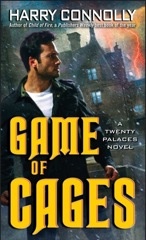 Ray is low on the totem pole of an organization called the “Twenty Palaces Society”. The Society exists to limit who has access to magic, because magic is really dangerous. People who wield it sometimes mistakenly think that they can control the creatures they summon from the Empty Spaces. The Society calls those creatures predators, because they want little more than to cross over into our world and enslave, eat, or simply kill all life on the planet.
Ray is low on the totem pole of an organization called the “Twenty Palaces Society”. The Society exists to limit who has access to magic, because magic is really dangerous. People who wield it sometimes mistakenly think that they can control the creatures they summon from the Empty Spaces. The Society calls those creatures predators, because they want little more than to cross over into our world and enslave, eat, or simply kill all life on the planet.
Annalise Powliss is a peer in the Society, and her job is to go around and stomp on magic — hard. She doesn’t use a cute Men In Black neuralizer device to erase people’s memories; she just kills them and takes their spell books. Ray is her Wooden Man, a role he first thinks of as subordinate, but which he later comes to understand is much closer to decoy, or simply bait.
As I mentioned earlier: there is no wise-cracking here, no jocular camaraderie. The job they do and the things they see take a terrible toll on them. This is a dark book, not a buddy movie. But despite the Lovecraftian terrors, disturbing twists, and grisly scenes, I would call it a grim thriller rather than a horror novel. This is perhaps what sets it apart from Charlie Stross’s Laundry books: their sometimes cheerful British attitude towards the end of the world belies a peculiar flavour of despair that does flag them as horror.
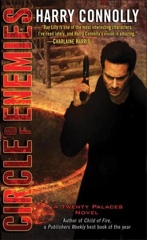 At the end of Child of Fire, I was completely drawn in to the world, and wanted to read more. Fortunately the second book in the series, Game of Cages was already in print, and the third, Circle of Enemies was due out at the end of August, so I didn’t have long to wait for my next fix.
At the end of Child of Fire, I was completely drawn in to the world, and wanted to read more. Fortunately the second book in the series, Game of Cages was already in print, and the third, Circle of Enemies was due out at the end of August, so I didn’t have long to wait for my next fix.
Both books are cracking good reads, as much in terms of the self-contained stories they tell as in what they reveal about Ray and Annalise, and the dangerous world they inhabit. The ghost knife that Ray wields turns out to be much more intriguing than just a tool and a weapon. Ray himself turns out to be much more capable than the typical Wooden Man. And the secretive Twenty Palaces Society itself turns out to be more fallible and less powerful than the world perhaps needs it to be. As tantalizing hooks for future plots go, it would be hard to beat the discovery Ray makes at the end of Circle of Enemies. I love finding new series, and this was a winner.
Or so I thought, until I saw a tweet that led me back to Harry Connolly’s blog, where he had posted an entry titled “It’s Official: The Twenty Palaces Series Has Been Cancelled (long)” on 14th October. Damn it.
There are no guarantees in writing. You work like crazy on a story that means a lot to you, and when you send it out into the world where it’s met with scorn, or indifference, or casual contempt. There are no guarantees that X will be a great story or that Y number of readers will fall all over it and spread the word. I know as well as anyone that no one owes me anything.
First Dananananaykroyd breaking up, then the Twenty Palaces series being cancelled. Noooooooo!
As Harry describes it, he got excellent support from his publisher, but the market just didn’t respond. The books got good reviews, and have gathered a loyal set of followers, but in the end not enough people bought them. I feel a kind of selfish disappointment that there won’t be any more books in the series, but just as George R.R. Martin is not my bitch, neither is Harry Connolly. All I can say is that he has gained an admirer in me, and I’ll be looking forward to anything he writes in the future.
The bright point at the end of this tale is that I do still have one more Ray Lilly story to savour. Just yesterday, Harry self-published Twenty Palaces, a prequel story to the whole series, in which Ray meets Annalise, creates his ghost knife, and sees a predator for the first time:
When Ray Lilly was 13 years old, a handgun accident landed his best friend, Jon Burrows, in a wheelchair and turned Ray into a runaway and petty criminal. Fifteen years later, Ray returns home after a stint in prison; he’s determined to go straight, but he knows he can’t do that without making peace with his old friend.
What Ray doesn’t expect is to discover that Jon has just received a mysterious cure–not only is he out of his wheelchair, he seems stronger and faster than… well, pretty much anyone. Worse, his cure has drawn all sorts of unwanted attention: the media are camped out on his block, the police are investigating him for insurance fraud, and weird shadowy figures have begun to draw closer, figures who clearly do not mean to do Jon any good.
Can Ray atone for the biggest mistake of his life by protecting his oldest and best friend? What’s more, should he?
I bought it ($4.99) as soon as I saw the blog post. What I didn’t realize until I got the PDF is that this “story” runs to a novel-length 268 pages. I’d been expecting something much shorter. As a fan of a cancelled series, that’s not just good value; it’s priceless.
